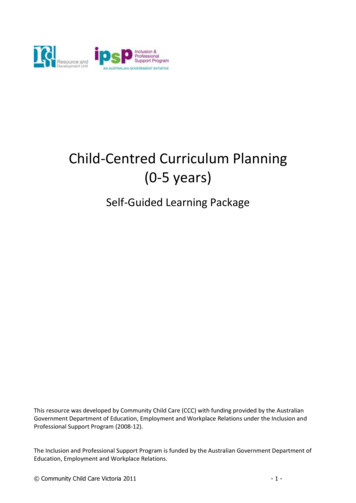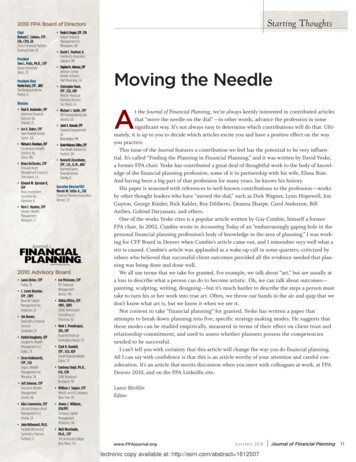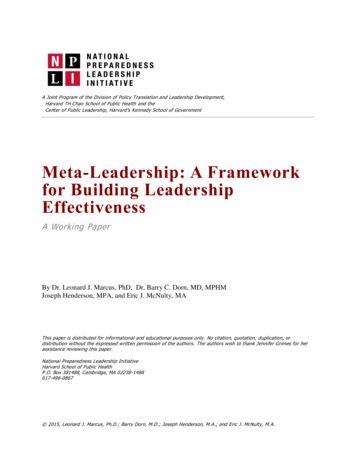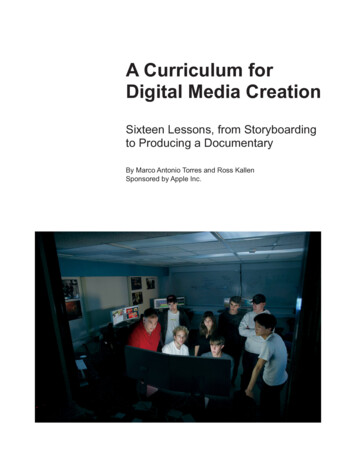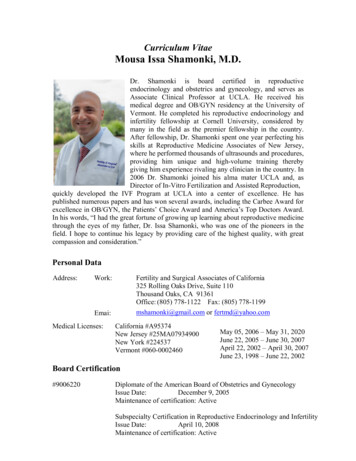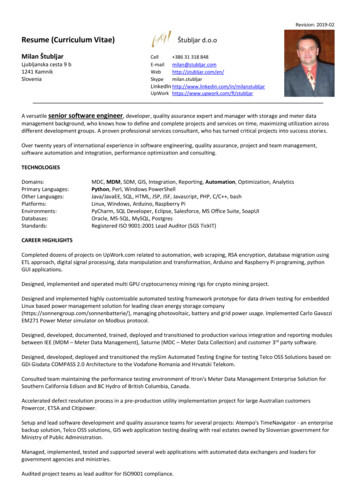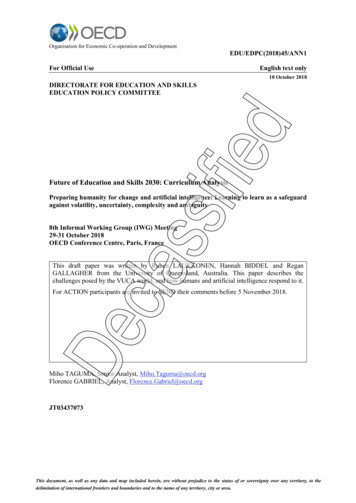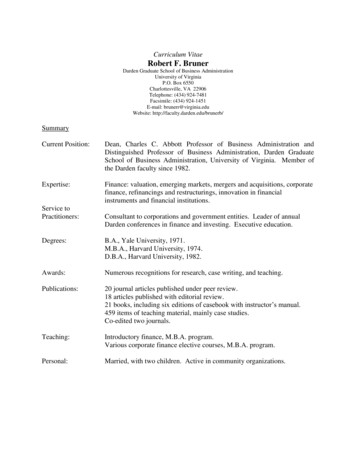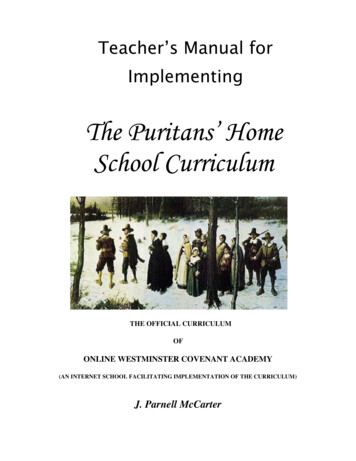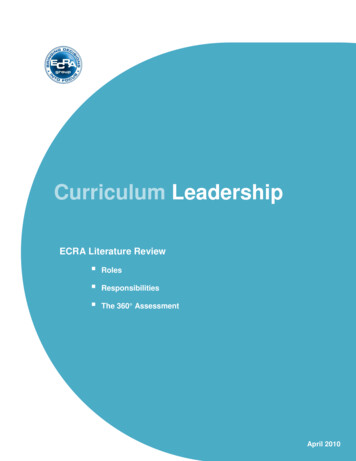
Transcription
Curriculum LeadershipECRA Literature Review Roles Responsibilities The 360 AssessmentApril 2010
ECRA Literature Review2 :.CONTENTS03Introduction: Curriculum Leadership and the 360º Appraisal04What is 360º Assessment?05How the School Leadership 360º was Constructed07Leadership Domains07Vision and Values07Curriculum and Instruction08Assessment and Research08Staff Development09Communication and Collaboration09Management10ReferencesECRA Group, Inc. 5600 N River Road, Suite 180, Rosemont, IL 60018WWW.ECRAGROUP.COM
3 :.ECRA Literature ReviewIntroduction: Curriculum Leadership and the 360 AppraisalCurriculum leadership involves a careful balance of instructional and administrative leadershipresponsibilities. The role is multi-faceted and complex, embedded not only in the formaltrappings of authority (as supervisor of faculty) but also in functions that cut across a number ofroles affecting student achievement, including professional development, professionalaccountability, and curriculum development (Ogawa & Bossert, 1995).Much of the current thinking on the role of the curriculum leader distinguishes the traditional, or―maintenance,‖ responsibilities commonly assigned to the position and the so-called ―dynamic‖tasks that extend the curriculum leader’s impact to community building and school improvementprocesses. The former reflect those tasks of managing the instructional program, such asspearheading textbook adoption, maintaining subject area expertise, and reviewing studentachievement; the latter includes vision-building, tailoring standards and benchmarks to theparticular needs of the student population, engaging and communicating with stakeholders, andmanaging the change process (Wiles, 2008). According to Wiles (2008), the most effectivecurriculum leaders embrace the dynamic role and go beyond the expected responsibilities. Theyestablish new directions, align people and resources, motivate participants, and aid schoolimprovement processes (Wiles, 2008). In this sense, strong leadership at the curriculummanagement level is also inclusive, embracing work that is carried out collaboratively withindividuals at different levels of the system and with different purviews over instruction(Spillane, Halverson, & Diamond, 2001).The Curriculum Leadership 360º Appraisal evaluates both the maintenance and dynamicresponsibilities of the curriculum leader.The most effective curriculum leaders: Embrace the dynamic role and go beyond expectations Establish new directions Align people and resources Motivate participants and aid school improvement processes Interpersonal skills Strategic action assessmentECRA Group, Inc. 5600 N River Road, Suite 180, Rosemont, IL 60018WWW.ECRAGROUP.COM
4 :.ECRA Literature ReviewWhat is 360º Assessment?Multisource feedback systems, commonly referred to as 360º assessments, refer to the process ofcollecting multiple viewpoints in order to provide a detailed and accurate picture of individualperformance. When 360º assessment is applied to school leaders, teams of evaluators are utilizedto gain the input of all members of the school’s professional community, thereby offering anoverall assessment of the individual (Fletcher & Baldry, 2000). Evaluators may includesupervisors (school board members, superintendents, etc.), colleagues (assistant superintendents,curriculum directors, etc.), school personnel (educators, office staff), and community members(parents, students, etc.). All participants respond to the same survey items, thereby providingmany perspectives and viewpoints on the actions and impact of the school leader being evaluated.Because 360º assessment focuses on feedback and subsequent action to strengthen schoolleadership, the method reflects the research literature’s support of the mechanism as a formativeevaluation tool to help school leaders focus on personal and leadership development and targetparticular areas for professional improvement (Moore, 2009). Furthermore, by comparing aleader’s perceptions with the evaluation of stakeholders, schools encourage enhanced selfawareness and performance improvement from all participants (Carlson, 1998). Anonymous360º feedback ensures leaders get honest feedback. In turn, it can create a culture whereindividuals become more ready to commit themselves to seeking and accepting feedback (Moore,2009; Fletcher & Baldry, 2000; Santeusanio, 1998). A 360º assessment, a multisource feedback system, is the processof collecting multiple viewpoints in order to provide a detailed andaccurate picture of individual performance.ECRA Group, Inc. 5600 N River Road, Suite 180, Rosemont, IL 60018WWW.ECRAGROUP.COM
5 :.ECRA Literature ReviewHow the School Leadership 360º Appraisal was ConstructedThe Curriculum Leadership 360º Appraisal is a comprehensive evaluation program that utilizes amulti-rater, evidence-based approach to measure the effectiveness of school leadership behaviorsknown to positively influence student achievement and school culture. The instrument consistsof 40 items that comprise six core domains, as well as an open-ended response item. In this 360ºevidenced-based assessment of leadership behaviors, each respondent rates the curriculumleader's effectiveness on a six-point scale. The curriculum leader in question does not need tohave performed the leadership behavior directly, but may have ensured that the behavior wasdone by others. The reference period is the current school year.ECRA initiated a multi-step development process to construct its 360º survey. The initial step ofany 360º assessment is to define the competencies of the position and to identify the learningoutcomes that are the target of the evaluation (Cottrell, Crow, & Shumway, 2007; Santeusanio,1998). Building upon its experience constructing program and talent evaluations, ECRA firstreviewed proprietary leadership evaluation instruments, including earlier work completed forIPA. Next, several evaluation tools were consulted, including standards from the InterstateSchool Leaders Licensure Consortium (ISLLC, 2008) and other current leadership evaluationinstruments on the market. An analysis of these standards and instruments led to theclassification of six domains of leadership criteria, qualities that reflect the balance mostcurriculum leaders seek in their role as both curriculum leader and manager-administrator(Jenkins, 2009). Many current leadership assessments vary greatly with respect to how muchthey focus on the managerial work of schools or on learning outcomes (Wallace Foundation,2009). The Curriculum Leadership 360º Appraisal, however, emphasizes leadership behaviorsrepresentative of effective curriculum leaders.This focus on best practices acknowledges the multifaceted role of the curriculum leaderwhile prioritizing the instructional focus and school guidance responsibilities thatcommonly define the 21st century curriculum leader.ECRA Group, Inc. 5600 N River Road, Suite 180, Rosemont, IL 60018WWW.ECRAGROUP.COM
6 :.ECRA Literature Review360º Appraisal ConstructionVision and Values —Items in this category measure the curriculum leader’s vision andcommitment to excellence; the alignment of district programs to the broader mission, vision andphilosophy of the district; and the promotion and upholding high expectations for allstakeholders, including his/her own professional behavior.Curriculum and Instruction—Items in this category measure the curriculum leader’sability to plan, implement, and assess the efficacy of the school or district’s instructionalprogramming.Assessment and Research—Items in this category measure the curriculum leader’sability to plan, implement, and evaluate the efficacy of the school or district’s assessmentprogramming, as well as to use that data and other sources of external research to inform schoolimprovement practices.Staff Development—Items in this category measure the curriculum leader’s role inevaluating and enhancing the professional skills of school personnel; the items address the hiringand retention of competent professionals, conducting teacher observations, and providingmeaningful professional development.Communication and Collaboration—Items in this category measure the schoolleader’s ability to involve stakeholders, particularly faculty, in realizing the school’s vision andimprove student achievement.Management —Items in this category measure the curriculum leader’s effectiveness inmanaging relevant school operations (e.g., budgeting, compliance), in monitoring organizationalperformance, and in providing oversight over the instructional program.ECRA Group, Inc. 5600 N River Road, Suite 180, Rosemont, IL 60018WWW.ECRAGROUP.COM
7 :.ECRA Literature ReviewLeadership DomainsThe following sections review the research literature supporting theinclusion of the six categories.Vision and ValuesAssistant superintendents of curriculum and instruction and/or department chairs function asleaders when they focus on improving key aspects of their school or district’s progress—including its mission, vision, engagement, and adaptability—and engage others in complex workto achieve these goals (Danielson, 2006; Marzano, Waters, & McNulty, 2005). By contributingto and directly engaging with the goals of their institution, they create policies, structures, andincentives that build upon school or district assets (Bowman, 2002; Wenger, McDermott, &Snyder, 2002). Effective curriculum leaders are proactive and analytical, conscious of emergingissues and concerns related to personnel. They pinpoint problems through effective questioning,monitor the effectiveness of school practices, and prioritize and coordinate plans of action withstaff members (Gabriel & Farmer, 2005; Marzano et al., 2005). Strong curriculum leaders takeresponsibility for their own behaviors and distribute leadership responsibilities to colleagues whoembrace the vision and goals of the school or district (Blase & Blase, 2000; Hatch, 2009). In sodoing, educational leaders create the conditions that maximize the actions of all stakeholders bymobilizing effort along multiple pathways that lead to student, professional, or system learning(Copland & Knapp, 2005; Laurie, 2001;Wiles, 2008).Curriculum and InstructionCurriculum leadership is a significant driver in improving academic achievement. Thecurriculum leader is directly involved in the design and implementation of curriculum,instruction, and assessment practices; it is his/her knowledge of instructional strategies, currentresearch, and application of student achievement data that gives shape to instructionalprogramming (Copland & Knapp, 2005). Teacher leaders earn credibility from other teachersrespect when their expertise and their personal and professional values on instruction positivelyinfluence school culture (Patterson & Patterson, 2004). By focusing on learning, teaching andmonitoring progress, curriculum leaders help educators improve their instructional practices andensure student achievement improves as a result of meaningful, supportive decisions aboutpedagogy, coursework, and instructional materials (King, 2002).ECRA Group, Inc. 5600 N River Road, Suite 180, Rosemont, IL 60018WWW.ECRAGROUP.COM
8 :.ECRA Literature ReviewAssessment and ResearchEffective leaders must have a keen ability to monitor the progress of instruction andanalyze achievement data to determine ongoing solutions to issues related to academicachievement (Danielson, 2006). They focus on specific, high-yield instructional practices;use assessment data to improve student learning and teacher practices; and remain vigilantabout adapting programming to changes in demographics, legislation, and/or researchtrends (Fullan, 2009; Gabriel & Farmer, 2005). They also strive for continuous selfimprovement in the field, continually adding to their knowledge base of curriculum,instruction, and assessment practices to ensure school programming is aligned to the latesteducational research so that the school or district’s instructional goals are within reach(King, 2002).Effective curriculum leaders: Focus on specific, high-yield instructional practicesUse assessment data to improve student learning and teacher practicesRemain vigilant about adapting programming to change in demographics,legislation, and/or research trends.Staff DevelopmentBecause the assistant superintendent or department chair directly affects teacher behaviorand attitudes, curriculum leaders are arguably the most powerful influence on theperformance of school faculty (Donaldson, 2007; DuFour & Eaker, 1998). Effectivecurriculum leaders are focused on enhancing teacher quality at all stages of the staffdevelopment process, including hiring, mentoring, evaluating, et al., and do so byestablishing clear criteria for professional growth and by applying differentiatedapproaches to the support and assessment of faculty (Danielson, 2001). The effectivecurriculum leader also provides extensive staff development, regular opportunities forteacher collaboration, and encourages the formation of professional learning communitiesthat lead to transformation from within (Copland & Knapp, 2005; Grossman, Wineburg, &Woolworth, 2001; Patterson & Patterson, 2004). They work alongside teachers in adultlearning activities such as study groups, school visits, and examination of students. Theyalso model exemplary practices for others, helping faculty and staff develop neededpedagogical skills and understanding (Ackerman & MacKenzie, 2006; King, 2002).ECRA Group, Inc. 5600 N River Road, Suite 180, Rosemont, IL 60018WWW.ECRAGROUP.COM
9 :.ECRA Literature ReviewCommunication and CollaborationResearch shows that teachers and students are most productive when they work in acontext of caring, support, and trust (Patterson & Patterson, 2004). Curriculum leadership,then, is also about cultivating relationships with those stakeholders who can contribute tothe school climate and encourage learning (Gabriel & Farmer, 2005; Hoerr, 2005).Effective leaders are visible on a regular basis; they communicate their vision and goals ina clear and timely manner; they listen to staff members and are mindful of their needs,wants, and concerns (Gabriel & Farmer, 2005). To be effective, curriculum leaders need tofacilitate professional dialogue, distribute or share responsibility, value the input of theircolleagues, make strategic use of staff members' special skills, and form leadership teamsto build strong support systems (Donaldson, 2007; Marzano, 2003; Marzano et al., 2005).In short, effective department chairs foster shared beliefs and a sense of community,recognize the influence of relationships on professional culture, and establish strong linesof communication and interaction to build additional assets for school growth andimprovement (Goletnan, Boyatzis, & McKee, 2002; Spillane, 2006; Marzano et al., 2005).ManagementImplementation of effective organizational processes influences student achievement (Davis etal., 2005). In order to foster instructional improvement, curriculum leaders must efficientlymanage relevant school operations, including staffing, budgeting, and compliance matters.Curriculum leaders monitor organizational performance, modify organizational structures thatmay undermine effective practice, and provide systems thinking to addressing concerns thatconnect administrative procedures to student achievement (Leithwood et al., 2004). Strongmanagerial skills allow all the other dimensions of schooling to aid the improvement of studentlearning (Knapp et al., 2003).ECRA Group, Inc. 5600 N River Road, Suite 180, Rosemont, IL 60018WWW.ECRAGROUP.COM
ECRA Literature Review10 :.ReferencesAckerman, R., & Mackenzie, S. (Eds.). (2006). Uncovering teacher leadership: Essays and voices fromthe field. Thousand Oaks, CA; Corwin Press.Ackerman, R., & Mackenzie, S. (2006). Uncovering teacher leadership. Educational Leadership, 63(8),66-70.Blase, J., & Blase, J. (2000). Effective instructional leadership: Teachers' perspectives on how principalspromote teaching and learning in schools. Journal of Educational Administration, 38(2), 130-141.Bowman, R.F. (2002). The real work of department chairs. Clearing House, 75(3) 158-62.Carlson, M.S. (1998). 360-Degree feedback: The power of multiple perspectives. Popular Government.Vol. 63 (2), 38-51.Copland, M.A., and Knapp, M.S. (2006). Connecting leadership with learning: A framework forreflection, planning, and action. Alexandria, VA: ASCD.Cottrell, S.; Crow, S.; Cottrell, L.; Shumway, J. (2007). Applying 360-degree evaluations to focus studentlearning and its improvement. In Educational Psychology Research Focus, Ed. E.M. Vargios. NovaPublishers.Danielson, C. (2001). New trends in teacher evaluation. Educational Leadership, 58(5), 12-15.Danielson, C. (2006). Leadership that strengthens professional practice. Alexandria, VA: ASCD.Darling-Hammond, L. (2003). Enhancing teaching. In W. Owens & L. S, Kaplan (Eds.), Best Practices,Best Thinking, and Emerging Issues in Leadership. Thousand Oaks, CA: Corwin Press.Donaldson, G.A (2006). Cultivating leadership in schools: Connecting people, purpose, and practice(2nd ed,). New York: Teachers College Press,Donaldson, G. A. (2007). What do teachers bring to Leadership? Educational Leadership, 65 (1), 26-29.DuFour, R., & Eaker, R. (1998). Professional learning communities at work: Best practices forenhancing student achievement. Bloomington, IN: National Educational Service.Fletcher, C., & Baldry, C. (2000). A study of individual differences and self-awareness in the context ofmulti-source feedback . Journal of Occupational & Organizational Psychology, 73 (3).Fullan, M. (2009). Leadership development: The larger context. Educational Leadership. 67 (2), 45-49.Gabriel, J., & Farmer, P. (2009). How to help your school thrive without breaking the bank. Alexandria,VA: ASCD.Goleman, D., Boyatzis, R. , & McKee, A. (2002). The emotional reality of teams. Journal ofOrganizational Excellence, 21(2), 55-65.Grossman, P., Wineburg, S., & Woolwonh, S. (2001). Toward a theory of teacher community. TeachersCollege Record, 3(6), 942-1002.Hoerr, T. R. (2005). The art of school leadership. Alexandria, VA: ASCD.Jenkins, B. (2009). What it takes to be an instructional leader. Principal, 88(3) 34-37.King, D. (2002). The changing shape of leadership. Educational Leadership, 59 (8).Knapp, M., Copland, M.A., Ford, B., Markholt, A. (2003). Leading for Learning Sourcebook: Conceptsand Examples. Center for the Study of Teaching and Policy, Dewitt Wallace-Reader’s Digest Fund, andLila Wallace-Reader’s Digest Fund, 2003.Leithwood, K., Seashore-Louis, K., Anderson, S., & Wahlstrom, K. (2004). How leadership influencesstudent learning (Learning From Leadership Project Executive Summary). New York: The WallaceFoundation.Marzano, R. J. (2003). What works in schools: Translating research into action. Alexandria, VA: ASCD.Marzano, R., Waters, T., & McNulty, B. A. (2005). School leadership that works: From research toresults. Alexandria, VA: ASCD.Moore, B. (2009). Improving the evaluation and feedback process for principals. Principal. 38-41.ECRA Group, Inc. 5600 N River Road, Suite 180, Rosemont, IL 60018WWW.ECRAGROUP.COM
ECRA Literature Review11 :.Ogawa, R., & Bossert, R. (1995). Leadership as an organizational quality. Educational AdministrationQuarterly, 31(2), 224–244.Patterson, J, & Patterson, J. (2004). Sharing the lead. Educational Leadership, 61(7), 74-78.Santeusanio, R. (1998). Improving performance with 360-degree feedback. Educational Leadership.Spillane, J., Halverson, R., & Diamond, J. (2001). Investigating school leadership practice: A distributedperspective. Educational Researcher, 30(3), 23–27.Wallace Foundation. (2009). Assessing the effectiveness of school leaders: new directions and newprocesses. New York City.Wenger, E., McDermott, R., & Snyder, W. (2002). Cultivating communities of practice. Boston: HarvardBusiness School Press.Wiles, J. (2008). Leading curriculum development. Thousand Oaks, CA: Corwin Press.Zepeda, S.J., & Kruskamp, B. (2007). High school department chairs: Perspectives on instructionalsupervision. The High School Journal, 90(4), 44-54.ECRA Group, Inc. 5600 N River Road, Suite 180, Rosemont, IL 60018WWW.ECRAGROUP.COM
Because 360º assessment focuses on feedback and subsequent action to strengthen school leadership, the method reflects the research literature’s support of the mechanism as a formative evaluation tool to help school leaders focus on personal and leadership development and target par
